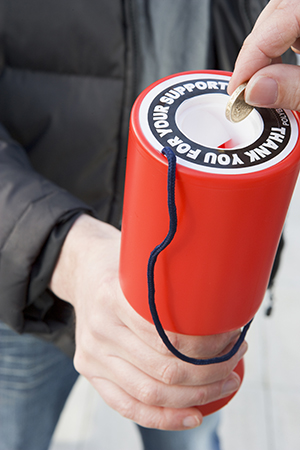2 Asking individuals for money

There are numerous ways to ask for money (far too many to cover in this course), so this is just a snapshot of some of the methods available.
As the fundraising marketplace becomes more competitive, organisations attempt to be more innovative in their approaches. Sometimes, asking individuals for money may involve giving them something in return; for example, when raising funds through crowdfunding, which is explained below. Estimates suggest that, on average, people in the UK give around 1 per cent of their income to charity (NCVO Knowhow Nonprofit, 2016).
Different ways that people donate to charity
Many people give one-off cash amounts to charities. It is usually a spontaneous gesture, such as putting coins into collection boxes in shops or pubs, a street collector’s bucket or an envelope put through their door. They might pay for tickets to fundraising events, such as school fetes, or sponsor someone on a charity run. Although many people give money in this way, it is a small percentage (around 18 per cent) of the total income from donations (NCVO Knowhow Nonprofit, 2016).
Planned giving is important to voluntary organisations as it involves a regular and potentially long-term commitment. This involves giving via direct debit; that is, paying a set amount each month. There is always scope to go back to the donor and ask them to raise their amount, too. However, if a person has felt pressurised into signing up, perhaps by a ‘chugger’, they might cancel their direct debit at a later date.
Fundraising ‘products’ include child sponsorship, food, blankets for people sleeping rough, endangered animal sponsorship, and so on. These can be made available through specialised websites such as goodgifts.org [Tip: hold Ctrl and click a link to open it in a new tab. (Hide tip)] or as one part of some charities’ fundraising activities; for example, Oxfam in their ‘unwrapped gifts’. People pay the specified amount for the product and know what their donation has paid for.
Crowdfunding involves advertising online (usually through specific crowdfunding websites) a particular initiative or activity for which a voluntary organisation is seeking money. The idea is that a lot of people give a small amount of money that adds up to a large amount. Sometimes this method involves getting something back, such as a book or a bag connected with the campaign, or an invitation to an event. The bigger the amount donated, the better the reward.
Gift aid enables UK registered charities to claim tax back from the government: they can claim 25p every time an individual donates £1. The donor needs to be a UK tax payer and is also required to complete a form.
Payroll giving is where employees donate to any UK registered charity from their gross salary (before tax is deducted) and receive tax relief.
